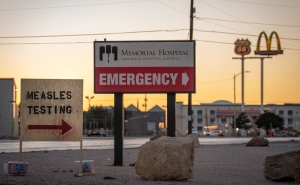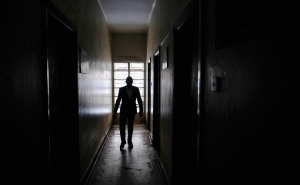Bringing Informed Decision-Making to Cancer Screening
“Get screened” shouldn’t be the full message, says one cancer prevention expert.

Screening for various cancers before a person experiences symptoms can help detect cancer in the early stages when treatment is often more effective. But there’s more to the message of “get screened” than most people realize, says Otis Brawley, MD, a Bloomberg Distinguished Professor with joint appointments in Epidemiology and the Sidney Kimmel Comprehensive Cancer Center, who emphasizes the importance of routine, high-quality screening with adequate follow-up.
For Cancer Prevention Awareness Month, Brawley talked with Public Health On Call host Stephanie Desmon about why it’s important for everyone to understand both the benefits and the risks of cancer screening in order to make informed decisions. This article is adapted from their conversation.
Cancer screening is more complex than just getting a test.
Many people think you just get the test, and if the test finds cancer, there is benefit. In fact, it’s far more complicated than that.
While family practice doctors and internal medicine doctors tend to be educated on it, it’s not something all doctors learn about in medical school.
There are cancers—for example, in the prostate and breast—that a person will never be bothered by, because they will ultimately die from something totally unrelated.
Cervical cancer screening saves lives.
In the case of cervical cancer—detected early with a Pap smear or advanced HPV testing—screening clearly saves lives. Women should be screened starting in their 20s. Certain tests should only be done once women are in their 30s through their 60s.
Don’t just get a mammogram. Get routine, high-quality mammography.
Screening for breast cancer saves lives, and it’s recommended that most women start at age 45. However, the message so frequently is to get a mammogram, when the message should be to get into a program of routine, high-quality mammography.
For example, most mammogram vans do not offer the opportunity for previous mammograms to be looked at. High-quality mammography, in my opinion, means that a person’s mammograms from last year and the year before are compared to this year’s.
Colonoscopies aren’t the only way to screen for colorectal cancer.
With colorectal cancer screening, everybody thinks “colonoscopy, colonoscopy.” Colonoscopies save lives and they can be done every 10 years. There’s also stool blood testing, which can be done every year, and stool DNA tests, which can be done every three years. Starting at age 45, those things should be done with adequate follow-up.
Lung cancer screening saves lives, but it’s not without risks.
There are about 140,000 to 150,000 lung cancer deaths a year in the United States. If we had full-scale lung cancer screening, we know that we would prevent perhaps 10,000 of them, but we would actually cause 1,500 to 1,800 deaths because of the diagnostics.
In lung cancer screening, it’s common that a radiologist will see something on an image that could be lung cancer, but could also be an old fungal infection or a scar from a bacterial infection 60 years prior. The only way to figure out whether or not it’s lung cancer is a transthoracic needle biopsy, which involves a controlled stab of a needle through a person’s chest and into the lesion while the person is in a CT scanner. If you stab enough people, you’re going to potentially cause a collapsed lung, and it’s possible the person will have a heart attack.
It’s recommended that people with an extensive smoking history understand the potential risks and benefits, and then find a high-quality screening program. That means a hospital or clinic that has thoracic surgery, good radiology, and good pulmonary medicine.
Prostate cancer screening is controversial. Here’s why.
The approach to prostate cancer screening has changed dramatically over the last 20 years. Now, about half of all men with screen-detected prostate cancer are told that the next step should be observation. The majority of those men are never going to be treated because they don’t need to be cured.
Most professional organizations, including the U.S. Preventive Services Task Force and Medicare, recommend “fair balance,” meaning informed decision-making. There have been studies that show that prostate cancer screening doesn’t save lives, and at least one study that shows that it does save lives, but very few.
One study suggests that prostate cancer screening with a blood test and digital rectal exam will reduce risk of death by 20%. Here’s what that actually means:
If you screen 1,000 men in their 50s on a regular basis over 15 to 20 years, you will diagnose 100 of those 1,000 men with prostate cancer, and ultimately four will die. If you take 1,000 men of the same age, and you don’t screen them over that same period of time, you will diagnose about 60 with prostate cancer because of symptoms, and five will die. That five per 1,000 unscreened going to four per 1,000 screened is where the 20% reduction in risk of death comes from. But it’s at a cost of almost doubling the man’s risk of being diagnosed with prostate cancer.
After an abnormal screen, follow-up is essential.
One of the problems we find is people have an abnormal screen and then don't get the diagnostics or treatment. Women will get a mammogram, be told there’s an abnormality, and a repeat mammogram and additional testing may be needed. A larger portion of poorer women don’t return for that follow-up evaluation.
One study suggests that of the 45,000 or so women who die from breast cancer every year, approximately 10% die because they never got a mammogram. And somewhere around 20-25% die because they did not get adequate follow-up or treatment following an abnormal mammogram.
Not everyone has access to the same quality screening.
In the case of mammography in the U.S., the proportion of Black women and white women in their 50s and 60s who get screened is the same, about 60%. The problem is that Black women more often get screened in centers that don't have previous mammograms for comparison.
With lung cancer screening, we see middle- and upper-middle-class individuals going to high-quality centers and poorer people going to community hospitals that don't offer all the various specialties that ensure high-quality screening.
One famous study of colon cancer screening and treatment showed that poor people in California were going to overcrowded hospitals, and the quality of the screening and diagnosis was impacted. In the hospitals poor people went to, a pathologist had to deal with six patients a day, but in the hospitals where middle-class people with good insurance went, the pathologist only had to deal with two patients a day. So there was a difference in quality because the doctor spent more time analyzing the patients with better insurance.
Each person should make their own informed decisions around screening.
Cancer screening saves lives. But that doesn't mean the recommendation is for everyone to get it. It means that we should have a conversation and respect people’s concerns. Those who are concerned or hesitant to get screened, perhaps ought not to. Those who want to get screened ought to be able to get screened, and we should remove financial barriers for them to do so.
Aliza Rosen is a digital content strategist at the Johns Hopkins Bloomberg School of Public Health.





